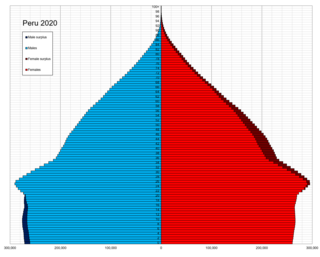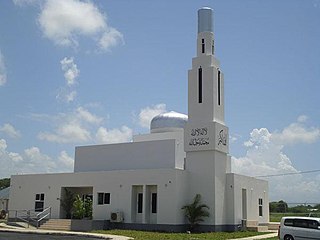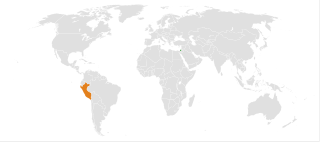
This is a demography of the population of Lebanon including population density, education level, health of the populace, economic status, religious affiliations and other aspects of the population.

This is a demography of the population of Peru including population density, ethnicity, education level, the health of the populace, economic status, religious affiliations and other aspects of the population.

The term Moor is an exonym first used by Christian Europeans to designate the Muslim populations of the Maghreb, al-Andalus, Sicily and Malta during the Middle Ages. Moors are not a single, distinct or self-defined people. The 1911 Encyclopædia Britannica observed that the term had "no real ethnological value." Europeans of the Middle Ages and the early modern period variously applied the name to Arabs, Berbers, and Muslim Europeans.
The terms multiracial people or mixed-race people are used to refer to people who are of more than one race and the terms multi-ethnic people or ethnically-mixed people are used to refer to people who are of more than one ethnicity. A variety of terms have been used both historically and presently for mixed race people in a variety of contexts, including multiethnic, polyethnic, occasionally bi-ethnic, Métis, Muwallad, Colored, Dougla, half-caste, ʻafakasi, mestizo, mutt, Melungeon, quadroon, octoroon, sambo/zambo, Eurasian, hapa, hāfu, Garifuna, pardo, and Gurans. A number of these terms are now considered offensive, in addition to those that were initially coined for pejorative use. "Melezi" are called the offspring of Muslim Romani men and woman of host populations.

Brazil is a predominantly Christian country with Islam being a minority religion, first brought by African slaves and then by Lebanese and Syrian immigrants. Due to the secular nature of Brazil's constitution, Muslims are free to proselytize and build places of worship in the country. However, Islam isn't independently included in charts and graphics representing religions in Brazil due to its very small size, being grouped in "other religions", which generally represent about 1% of the country's population. The number of Muslims in Brazil, according to the 2010 census, was 35,207 out of a population of approximately 191 million people. This corresponds to 0.018% of the Brazilian population.
Latin Americans are the citizens of Latin American countries.

Slavery in the Spanish American colonies was an economic and social institution which existed throughout the Spanish Empire including Spain itself. Indigenous peoples were enslaved and their populations decimated. Subsequently enslaved Africans were brought over. Native people were also subjected to forced conversions and conscription.

Black Peruvians or Afro-Peruvians are Peruvian of mostly or partially African descent. They mostly descend from enslaved Africans brought to Peru after the arrival of the conquistadors.

The Lebanese people are the people inhabiting or originating from Lebanon. The term may also include those who had inhabited Mount Lebanon and the Anti-Lebanon Mountains prior to the creation of the modern Lebanese state. The major religious groups among the Lebanese people within Lebanon are Shia Muslims (27%), Sunni Muslims (27%), Maronite Christians (21%), Greek Orthodox Christians (8%), Melkite Christians (5%), Druze (5.2%), Protestant Christians (1%). The largest contingent of Lebanese, however, comprise a diaspora in North America, South America, Europe, Australia and Africa, which is predominantly Maronite Christian.

Argentina is a predominantly Christian country, with Islam being a minority religion. Due to secular nature of the Argentine constitution, Muslims are free to proselytize and build places of worship in the country.

Islam in the Dominican Republic is a minority religion. Accurate statistics of religious affiliation are difficult to calculate and there is a wide variation concerning the actual numerical amount. Although the majority of the population is Christian, Muslims have formed local organizations such as the Círculo Islámico de República Dominicana and the Islamic Center of the Dominican Republic. Currently, the Círculo Islámico estimates that Muslims number over 4,000, including of a good number of local converts. Most recently, there has been another organization, led by native born Muslim converts, the Entidad Islámica Dominicana or EID.

Venezuela is a predominantly Christian country, with Islam being a minority religion. There are approximately 100,000 Muslims in Venezuela which make up 0.4 percent of the nation's population. Venezuela has a small but influential Muslim population. Many of them are Arabs of Lebanese, Palestinian, Syrian and Turkish descent.

Panama is a predominantly Christian country, with Islam being a minority religion. Due to the secular nature of Panama's constitution, Muslims are free to proselytize and build places of worship in the country.

Cuba is a majority Christian nation, with Islam being one of the smallest minority faiths in the country. According to a 2011 Pew Research Center report, there were then 10,000 Muslims in Cuba who constitute less than 0.1% of the population. As of 2012, most of the 10,000 Cuban Muslims were converts to the religion.

Jamaica is a predominantly Christian country, with Islam being a minority religion. Due to the secular nature of Jamaica's constitution, Muslims are free to proselytize and build places of worship in the country.

According to 2007 statistics released by the U.S. Department of State concerning Islam in Nicaragua, there are approximately 1,200 to 1,500 Muslims, mostly Sunnis who are resident aliens or naturalized citizens from Palestine, Libya, and Iran or natural-born Nicaraguan citizens born to both of the two groups. The Islamic Cultural Center in Managua serves as the primary salaat (prayer) center for Muslims in the city, with approximately 320 men attending on a regular basis. Muslims from Granada, Masaya, Leon, and Chinandega also travel to the Managua center for Friday prayers. Granada, Masaya, and Leon have smaller prayer centers in the homes of prominent local Muslims. In May 2007 the Sunni leader of the Managua prayer center was dismissed, due to the increase in Iranian influence in the Muslim community and was to be replaced by a Shi'a religious leader. By the end of the reporting period the Shi'a leader had not been identified.

Sunni Islam is a major religion in Palestine, being the religion of the majority of the Palestinian population. Muslims comprise 85% of the population of the West Bank, when including Israeli settlers, and 99% of the population of the Gaza Strip. The largest denomination among Palestinian Muslims are Sunnis, comprising 98–99% of the total Muslim population.
Arabs in Europe are people of Arab descent living in Europe today and over the centuries. Several million Arabs are residents in Europe. The vast majority form part of what is sometimes called the "Arab diaspora", i.e. ethnic Arabs or people descended from such living outside the Arab World. Most of the Arabs in Europe today are from the Maghreb.
African-American Muslims, also colloquially known as Black Muslims, are an African American religious minority. African American Muslims account for over 20% of American Muslims. They represent one of the larger minority Muslim populations of the United States as there is no ethnic group that makes up the majority of American Muslims. They are represented in Sunni and Shia denominations as well as smaller sects, such as the Nation of Islam. The history of African-American Muslims is related to African-American history in general, and goes back to the Revolutionary and Antebellum eras.

Palestine–Peru relations are bilateral relations between the State of Palestine and Peru. Peru recognized Palestine as a sovereign state on 24 January 2011. Both nations are members of the Non-Aligned Movement. Palestine has an embassy in Lima.















